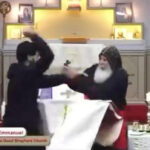A review of Understanding Islamic Terrorism: The Islamic Doctrine of War. By Patrick Sookhdeo.
Isaac Publishing, 2004.
Islamic terrorism is undoubtedly one of the most urgent problems facing the world today. As such it needs to be addressed and solutions provided. But in order to deal with it, we must first properly understand the problem.
This book is one of the better and more recent explorations of the topic, giving us a thorough background to, and understanding of, the various issues involved. Patrick Sookhdeo is well-placed to address this issue, being a leading authority on the topic at hand. This well-researched and comprehensive volume gives us a rich understanding of the theological, historical and ideological features of the debate.
Sookhdeo is quite aware of the wide diversity of understanding and interpretation of the Islamic doctrine of war. Indeed, questions abound for both Muslims and non-Muslims: How do we understand jihad? Is Islam a religion of peace? Must Muslims engage in warfare? Is terrorism a logical inference from Islamic teaching? Is there one standard understanding in Islam that can be appealed to? How much weight do we give to the various interpretations? The questions are many and profound.
Yet Sookhdeo has been able to wade through the plethora of questions and provide some cogent and convincing answers. A beginning point to the many debates lies in the source of authority in Islam. Of course the Koran takes pride of place, but almost as important are the hadith (the traditions recording what Mohammed and his early followers said and did) and Shari’ah (Islamic law covering every aspect of life).
The author argues that from these three sources one can detect a clear teaching on the use of force and violence within traditional Islam. What do these three sources tell us about war and peace in Islam? There is no question that the Koran contains many clear suras (chapters) describing the obligation to use force, to wage war against the infidel, and so on.
Of course the Koran also contains many passages on peace and forgiveness. However, most of these peace suras come from the earliest-dated verses. But the Islamic doctrine of naskh (abrogation) declares that whenever there is a conflict between suras, the later ones take priority over the earlier ones.
The concept of jihad (literally, striving) can also take on a host of meanings. But Sookhdeo shows that from the beginning of classic Islam, the three main sources all pointed to an understanding of jihad as primarily militaristic. The hadith, for example, from very early onwards, show an understanding of jihad as mainly including physical warfare and literal killing. And Shari’ah also includes a clear concept of jihad as involving actual warfare.
In fact, some Muslims believe jihad is the sixth pillar (central teaching) of Islam. Thus Osama bin Laden could argue that “jihad continues to be a commandment incumbent personally upon every Muslim”.
Another way of settling the question as to whether Islam is a religion of peace or not is to focus on the wider Islamic understanding of the world. Classic Islam divides the world into two main camps, Dar al-Islam (the house of Islam) and Dar al-harb (the house of War). The former refers to all those under the rule of Islam, and the latter to those who are not. Muslims are under obligation to move all those in the house of War to the house of Islam. While there are many ways to achieve this, it is clear that the primary means for Mohammed and his early followers was by military conquest.
And since Mohammed holds such a high place in Islam, his actions become exemplary for his followers. And since Islam is not divided but one, to expand the religion of Islam is to expand its military and political domain as well. Thus a good Muslim will want to see all the world under the rule of Islam (‘Islam’ means ‘submission’).
Indeed, traditional Muslims consider it blasphemous when non-Muslims rule over Muslims. While moderate Muslims today may not want to see Islam promoted by the edge of the sword, militant Muslims and terrorists certainly do, and they feel they have proper theological and historical justification for doing so.
Consider also the Islamic understanding of peace. Peace is seen more as a negative, temporal and limited concept, while war, as defined above, is seen as a positive, ongoing and complete concept. Thus peace may be viewed as an interlude in jihad until all of the non-Muslim world submits to the house of Islam. Permanent peace in fact can only occur in the house of Islam. As long as some are outside that rule, real peace is not possible.
Just as there is no equivalent tradition of jihad in Christianity, the Christian tradition of pacifism (one of several Christian options concerning war and peace) is almost unknown in classic Islam. Where pacifism is preached in Islam is in its more mystic versions, and where a more spiritual understanding of jihad is held, as among the Sufis.
Sookhdeo tackles the question of war and peace in other ways in this book. He has extended historical discussions of Mohammed and his followers; various violent sects and movements within Islam; the motivation, training and activities of Islamic terrorists and suicide bombers; and a detailed discussion of martyrdom and suicide in Islam.
Concerning the last point, Sookhdeo reminds us that while suicide per se appears to be condemned in the Koran, the passages cited are in fact somewhat tenuous, and many radical Muslims are ready to argue that suicide bombing is really a form of martyrdom, not suicide. Indeed, Islamic radicals do not use the term ‘suicide bomber’ but shahid (martyr or witness).
In this regard it is interesting to note that no mainstream Islamic leader issued a fatwa (authoritative statement) condemning the suicide bombers following the September 11 attack.
Indeed, there are many reasons why a radical Muslim might take up suicide bombings. Several can be mentioned here. Many see such activity as an Islamic duty. The original sources of Islam seem to make this a duty to God, and most terrorists are in fact devout Muslims, who take their faith seriously. Of course there is heated debate within Islam as to whether this activity can be seen as a religious duty, or even legitimate.
Also, for Muslims such a death is the only sure guarantee of eternal reward. All other Muslims have no such assurance that they will make it to paradise and experience forgiveness of sins. Both the Koran and hadith speak of the heavenly reward of the one who dies in jihad, and great honour is placed on this activity.
Sookhdeo concludes with a chapter on what is to be done. He canvasses a number of options (including the observation that Islamic expansion in the past has only been stopped by military force), but argues that our best hope is to see Islam reformed from within. We must encourage moderate Muslims in their process of reform and do all we can to allow Islam to weed out the radicals. The process will be long and difficult, but it must be attempted.
In sum, this is an important examination of one of our most pressing problems. This book goes a long way to dispelling the myths, and setting the record straight. We need to properly identify and recognize the enemy (radical Islamists) before we can adequately confront them. Only a right understanding of the problem can lead to its hoped-for solution.
[1235 words]




















I don’t know if Sookhdeo covers this or not, but when some argue that the hadiths can be dismissed, I usually point out that the hadiths and the sira make up the sunna which can not be dismissed. I’ve found that people cannot argue that point since they cannot condemn Mohammad. So, it’s always important to argue that the sunna, along with the Koran, is the basis for sharia law. If Mohammad did it or said it was okay to do, it is perfectly fine in Islam. If Mohammad said don’t do it, then it’s not permitted in Islam.
That’s also the Islamic version of morality.
Kendra Mallock, USA
Thanks Kendra
Yes he does cover that ground, and even more so in his newer and much larger Global Jihad. See my review of that here: https://billmuehlenberg.com/2008/11/12/a-review-of-global-jihad-by-patrick-sookhdeo/
Bill Muehlenberg, CultureWatch